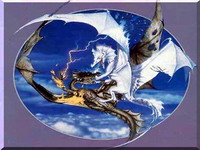
Dragons are arguably the most diverse of creatures; they appear in history, mythology, literature, religion, art, and of course, our imaginations. Of all the fantasy creatures, they are the most well-known and they differ so incredibly that it is quite hard to not become intrigued by them. Dragons also appear in almost every culture, civilisation and region.
The two most popular types of dragons are the well-known Western type that frequently appeared in the Middle Ages, and the beneficial snake-like dragons of Ancient China. But the term 'dragon' applies to any creature that is different: for example, the Chimera is a dragon. It has the body and head of a dragon, a goat head on its back and a snake head at the end of its tail. Other creatures made up of different animal parts are also dragons, such as the Mexican dragons which possess traits of jaguars.
This is only partly why dragons so diverse. (Note that dragon is not just a term under which assorted creatures are placed in: these animals, such as the Chimera, have been directly named as belonging to the draconic race.)
The most likely reason why dragons are so well-known and arguably the most famous mythical creature is because their diversity makes them very flexible. In a person's imagination, a dragon can take on virtually any form a person can dream up.
Also, dragons have changed so dramatically over the thousands of years they have been in existence.
Dragons were originally beneficial creatures that were closely linked with the creation and shaping of our world. This image of the creator-dragon is a common theme that has been carried through many cultures and even some religions.
The first dragons belonged to the oldest culture still present today in much the same form; the Australian Aboriginals. Here, they were revered creatures who generally kept to themselves and didn't have much to do with people, except in the case of the creator-dragon, the Rainbow Serpent. Ancient China also featured dragons of much the same temperament in their culture and everyday life.
Other ancient civilisations such as Ancient Egypt and Persia saw the dragon as a symbol of life and death. Here, they had traits of both good and evil, depending on the individual.
However, the dragon is not without its bad side (as they are commonly known for), and have built up an infamous reputation in the past that has, undoubtedly, been a large contributing factor to their popularity.
It was this aspect of the dragon's personality (and more recently their good side, as seen in the Ancient Chinese dragons), which are most commonly remembered.
Dragons are generally seen as holding their own personalities. Today, dragons have become very popular among the fantasy and science fiction genre. However, the recently developed stigma surrounding the dragon (this is one of, "everyone thinks dragons are evil, but I know they're not. No-one understands dragons.") is in most cases false.
The dragon's sinister, bestial side is something which has been embraced by the media, but so too has their gentle, noble aspects. A good example is the movie Dragonheart.
However, without their darker side, the dragon would not be what it is today. Dragons would no longer be a symbol of strength, courage and ferocity, but would essentially become a Unicorn with wings and claws.
Dragons may have had a bad reputation at one stage, but today they are generally seen as creatures with their own personality, their own likes and dislikes, and their own temperaments.
Through the thousands of years, the dragon's personality has changed dramatically. They were first created as good creatures who generally kept to themselves, but as the years passed they came to stand for both good and bad. The creator-dragon was a popular idea which was carried through many cultures and civilizations (Tiamat, Aido-Wedo, Jormungand, etc).
The dragon has always held an element of evil in its image, which was carried through as its personality changed through time.
Dragons have differed in the numerous cultures so incredibly, in appearance and personality alike.
Today, the dragon's image and personality has changed again. Now, they are seen as creatures holding their own personalities and temperaments. They have become much more popular; certainly part of this is due to the bad reputation they held hundreds of years ago.
